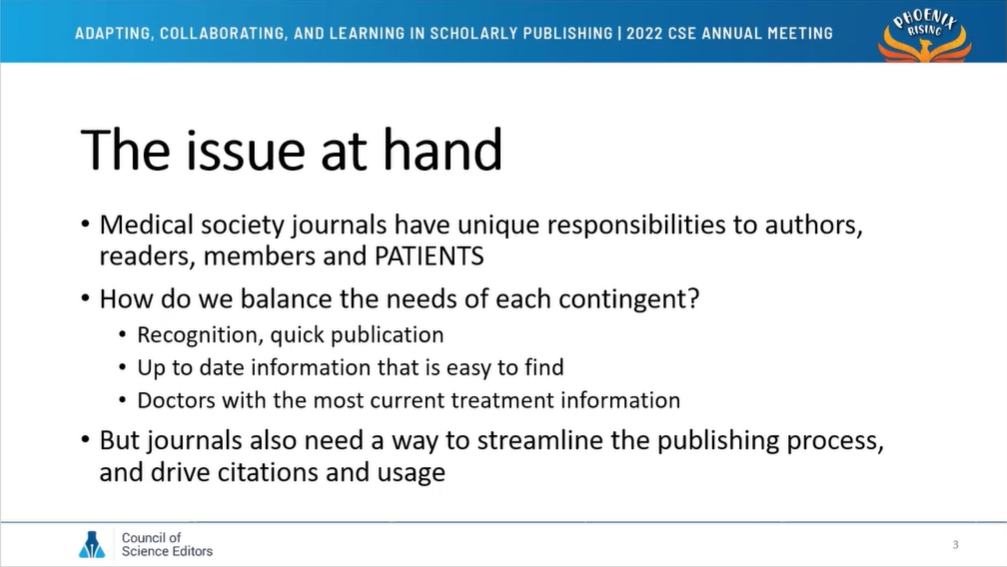MODERATOR:
Emilie Gunn
American Society of Clinical Oncology
Alexandria, Virginia
@emiliemgunn
SPEAKERS:
Jill Jackson
Annals of Internal Medicine
Philadelphia, Pennsylvania
Dax Rodulfa-Blemberg
American Society of Hematology
Washington, DC
Helen Macdonald
BMJ
United Kingdom
REPORTER:
Heather DiAngelis
Transportation Research Board at the National Academies of Sciences, Engineering, and Medicine
Washington, DC
@hdiangelis
As noted by Emilie Gunn, Director of Journals at the American Society of Clinical Oncology, it is becoming increasingly important for medical societies to implement rapid updates to guideline publications to provide the most current recommendations to clinicians and medical professionals. Medical societies have unique responsibilities to authors, readers, members, and patients, and publishers must balance the needs of each contingent; at the same time, journals need a way to streamline the publishing process while also driving citations and usage. Three speakers from medical journals presented about how their organizations were adapting their guideline publication processes to meet these challenges.

Jill Jackson, Managing Editor for Annals of Internal Medicine, was the first presenter; she provided an overview of Annals’s processes and policies for updating living guidelines after publication, which began in 2020 and are also known as “practice points” within the journal. Jackson defined practice points as “living advice that regularly assesses and incorporates new evidence” and noted that they are designed to “provide clinical advice based on the best available evidence for the public, patients, clinicians, and public health professionals.” The editorial staff regularly reviews living guidelines to request updates, which sometimes involves the author creating a heavily updated version of the article that becomes Version 2. In addition, minor updates are published as a letter and linked to the original article.
Dax Rodulfa-Blemberg, Senior Managing Editor for the Blood Journals at the American Society of Hematology, spoke second. His organization used the publishing model for errata as a framework for creating processes for living guidelines; using a similar method, they were able to publish updates as individual publications interlinked with the original guideline. The top considerations of living guidelines included the function and purpose of the publication, how to correctly identify authorship, discoverability of updates, and flexibility of content. Rodulfa-Blemberg noted that as their model grows, flexibility remains the most difficult hurdle to refine.
Dr. Helen Macdonald, Research Integrity Editor at BMJ, described her organization’s desire to shift from pre-pandemic processes for guideline updates. This included a single DOI and title, the word “living” in the title, a post production resend, a forecast section for potential future updates, and old versions stored as supplementary files. She noted that living content also has major author implications that require discussion, such as authorship changes, DOIs, timelines and approaches for updates, approaches to internal and external peer review, and funding.
During the extensive question-and-answer period that followed, Jackson, Rodulfa-Blemberg, and Macdonald addressed the challenges and decision-making behind naming and dating various versions of content and defining authorship, visions for non-COVID-related guidelines, and the origination of their respective models.
